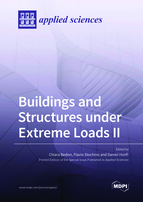Buildings and Structures under Extreme Loads II
A special issue of Applied Sciences (ISSN 2076-3417). This special issue belongs to the section "Civil Engineering".
Deadline for manuscript submissions: closed (15 August 2021) | Viewed by 39433
Special Issue Editors
Interests: sustainability; numerical simulation; structural analysis; structural dynamics; constructions; finite element analysis; numerical modelling
Special Issues, Collections and Topics in MDPI journals
2. Edificio A, Via Marengo 2, 09123 Cagliari, Italy
Interests: design of reinforced concrete structures and use of recycled construction materials; analyses of extreme load on structures
Special Issues, Collections and Topics in MDPI journals
Interests: structural engineering; structural safety; robustness; resilience; serviceability of structures
Special Issues, Collections and Topics in MDPI journals
Special Issue Information
Dear Colleagues,
Exceptional design loads on buildings and structures may have different causes, including high-strain natural hazards, man-made attacks, and accidents, as well as extreme operational conditions (severe temperature variations, humidity, etc.). All of these aspects can be critical for specific structural typologies and/or materials that are particularly sensitive to external conditions. In this regard, dedicated and refined methods are required for their design, analysis, and maintenance under the expected life-time. Major challenges are related to their structural typology and material properties, with respect to the key features of the imposed design load. Further issues can be derived from the need for the mitigation or retrofit of existing structures, as well as from the optimal and safe design of innovative materials/systems. Finally, in some cases, no appropriate design recommendations are available, and thus experimental investigations can have a key role within the overall process.
In this Special Issue, we invite the publication of original research studies, review papers, and experimental and/or numerical investigations on the structural performance of buildings and structures (including the analysis at the material, component, or assembly level) under exceptional loads. Both new design projects or the retrofit and mitigation of existing structures will be of interest for the Special Issue.
Dr. Chiara Bedon
Dr. Flavio Stochino
Dr. Daniel Honfi
Guest Editors
Manuscript Submission Information
Manuscripts should be submitted online at www.mdpi.com by registering and logging in to this website. Once you are registered, click here to go to the submission form. Manuscripts can be submitted until the deadline. All submissions that pass pre-check are peer-reviewed. Accepted papers will be published continuously in the journal (as soon as accepted) and will be listed together on the special issue website. Research articles, review articles as well as short communications are invited. For planned papers, a title and short abstract (about 100 words) can be sent to the Editorial Office for announcement on this website.
Submitted manuscripts should not have been published previously, nor be under consideration for publication elsewhere (except conference proceedings papers). All manuscripts are thoroughly refereed through a single-blind peer-review process. A guide for authors and other relevant information for submission of manuscripts is available on the Instructions for Authors page. Applied Sciences is an international peer-reviewed open access semimonthly journal published by MDPI.
Please visit the Instructions for Authors page before submitting a manuscript. The Article Processing Charge (APC) for publication in this open access journal is 2400 CHF (Swiss Francs). Submitted papers should be well formatted and use good English. Authors may use MDPI's English editing service prior to publication or during author revisions.
Keywords
- structural analysis
- extreme design loads
- experiments
- numerical modelling
- safety
- monitoring
- mitigation








